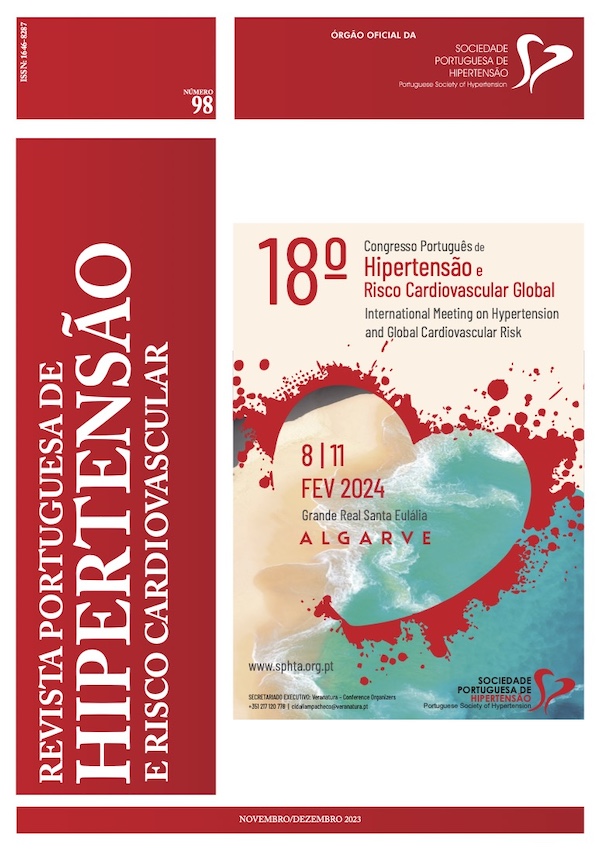INFLUÊNCIA DA HIPERTENSÃO ARTERIAL NO ACIDENTE VASCULAR CEREBRAL ISQUÉMICO: RELAÇÃO ÍNTIMA QUE É PRECISO COMBATER
DOI:
https://doi.org/10.58043/rphrc.110Palavras-chave:
Hipertensão arterial, Acidente Vascular Cerebral Isquémico, Fatores de Risco CardiovascularResumo
Introdução: O Acidente Vascular Cerebral (AVC) é uma causa importante de morbilidade na Europa e a primeira causa de morte em Portugal, a maioria é de natureza isquémica (69-75%). A hipertensão arterial (HTA) é o fator de risco mais importante para a morbilidade e mortalidade cardiovascular, sendo um fator de risco major para o AVC isquémico (AVCi). O presente estudo teve como objetivo avaliar a prevalência de HTA como fator de risco em doentes que apresentaram AVCi tendo em conta a frequência da pressão arterial (PA) à admissão, classes de anti hipertensores mais usadas e alterações terapêuticas à data de alta.
Materiais e Métodos: Estudo observacional retrospetivo onde foram incluídos doentes com AVCi internados na Unidade de AVC de um hospital distrital, entre 1 de janeiro de 2019 e 15 de novembro de 2019. Os autores recolheram os dados tendo em conta codificação de GDH’s e consulta de processos clínicos.
Resultados e Discussão: Dos 199 doentes internados na Unidade de AVC foram incluídos 173 doentes com o diagnóstico de AVC isquémico Dos 173 doentes incluídos no estudo, 43,9% eram do sexo feminino e 56,1% do sexo masculino, dos quais 73% apresentavam diagnóstico de HTA. Destes 66% estavam medicados e 7% tinham diagnóstico, mas não estavam medicados. À entrada no serviço de urgência apenas 22% dos doentes com diagnóstico prévio de HTA e medicados estavam normotensos. Recebiam monoterapia 60% dos pacientes. Dos fármacos usados a maioria pertencia aos de 1a linha, sendo os Inibidores da Enzina Conversora de Agiotensina (IECA’s) os mais usados (33%). À data de alta 31.2% mantiveram terapêutica, 26% modificaram terapêutica e 15% iniciaram terapêutica de novo.
Conclusão: É de suma importância o controlo adequado da HTA no AVC isquémico, como fator de risco modificável tanto na prevenção primária como secundária. Por isso, o controlo eficaz da PA é a grande arma contra o AVC.
Downloads
Referências
Biller J, Love BB, Schneck MJ. Vascular Diseases of the Nervous System: ischemic cerebrovascular disease. En: Bradley WG, Daroff RB, Fenichel G, Jankovic J, editores. Neurology in Clinical Practice Principles of Diagnosis and Management. 5th ed. Philadephia: Elsevier Inc; 2008. p. 1165–216.
Furie K, Kasner S, Adams R, Albers G, Bush R, Fagan S, et al. Guidelines for the Prevention of Stroke in Patients With Stroke or Transient Ischemic Attack: A Guideline for Healthcare Professionals From the American Heart Association/American Stroke Association. Stroke. 2011;42:227–76.
Fox CS, Evans JC, Larson MG, et al. Temporal trends in coronary heart disease mortality and sudden cardiac death from 1950 to 1999: the Framingham Heart Study. Circulation, 2004;110:522-527.
Grysiewicz RA, Thomas K, Pandey DK. Epidemiology of ischemic and hemorrhagic stroke: incidence, prevalence, mortality, and risk factors. Neurol Clin 2008; 26:871.
Harmsen P,Lappas G,Rosengren A,Wilhelmsen L. Long-term risk factors for stroke: twenty-eight years of follow-up of 7457 middle-aged men in Göteborg, Sweden. Stroke 2006; 37:1663.
O’Donnell MJ, Chin SL, Rangarajan S, et al. Global and regional effects of potentially modifiable risk factors associated with acute stroke in 32 countries (INTERSTROKE): a case-control study. Lancet 2016; 388:761.
Chalmers J, Beilin L, Mancia G, Whitworth J, Zanchetti A. International Society of Hypertension (ISH): statements on blood pressure and stroke. J Hypertens.2003; 21:651.
Graeme J. Hankey Lowering blood pressure. En: Stroke Treatment and Prevention An Evidence-Based Approach. Cambridge: Cambridge University Press; 2005. p. 288–95.
Blood Pressure Lowering Treatment Trialists’ Collaboration. Effect of different blood-pressure lowering regimens on major cardiovascular events: results of prospectively designed overviews of randomised trials. Lancet. 2003;362:1527–35.
Kannel WB. Risk stratification in hypertension: new insights from Farmingham Study. Am J Hypertens, 2000;13:3S-10S
Lewington S, Clarke R, Qizilbash N, et al. Age-specific relevance of usual blood pressure to vascular mortality: a meta-analysis of individual data for one million adults in 61 prospective studies. Lancet 2002; 360:1903.
Caplan LR. Basic pathology, anatomy, and pathophysiology of stroke. In: Caplan’s Stroke: A Clinical Approach, 4th ed, Saunders Elsevier, Philadelphia 2009. p.22.
AppelrosP,StegmayrB,TerentA.Sexdifferences in stroke epidemiology: a systematic review. Stroke.2009; 40(4):1082-90.
Gargano JW, Reeves MJ. Sex differences in stroke recovery and stroke-specific quality of life: results from a statewide stroke registry. Stroke. 2007;38(9):2541-8.
Reeves MJ, Bushnell CD, Howard G, Gargano JW, Duncan PW, Lynch G, et al. Sex differences in stroke: epidemiology, clinical presentation, medical care, and outcomes. Lancet Neurol. 2008;7(10):915-26.
Kernan WN, Ovbiagele B, Black HR, et al. Guidelines for the prevention of stroke in patients with stroke and transient ischemic attack: a guideline for healthcare professionals from the American Heart Association/American Stroke Association. Stroke 2014; 45:2160.
Rothwell PM, Howard SC, Dolan E, et al. Prognostic significance of visit-to-visit variability, maximum systolic blood pressure, and episodic hypertension. Lancet 2010; 375:895.
Touzé, E.; Coste, J.; Voicu, M. et al. “ mportance of in-hospital iniciation of the therapies and therapeutic inertia in secundary stroke prevntion. IMPACT study”. Stroke, 2008,39; 1834-1343
Whelton PK, Carey RM, Aronow WS, et al. 2017 ACC/AHA/AAPA/ABC/ACPM/AGS/ APhA/ASH/ASPC/NMA/PCNA Guideline for the Prevention, Detection, Evaluation, and Management of High Blood Pressure in Adults: A Report of the American College of Cardiology/ American Heart Association Task Force on Clinical Practice Guidelines. Hypertension 2018; 71:e13.
Wang WT, You LK, Chiang CE, et al. Comparative Effectiveness of Blood Pressure-lowering Drugs in Patients who have Already Suffered From Stroke: Traditional and Bayesian Network Meta-analysis of Randomized Trials. Medicine (Baltimore) 2016; 95:e3302.
Liu L, Wang Z, Gong L, et al. Blood pressure reduction for the secondary prevention of stroke: a Chinese trial and a systematic review of the literature. Hypertens Res 2019; 32:1032.
Arima H, Chalmers J, Woodward M, et al. Lower target blood pressures are safe and effective for the prevention of recurrent stroke: the PROGRESS trial. J Hypertens 2006; 24:1201.
Powers WJ, Rabinstein AA, Ackerson T, et al. 2018 Guidelines for the Early Management of Patients With Acute Ischemic Stroke: A Guideline for Healthcare Professionals From the American Heart Association/American Stroke Association. Stroke 2018; 49:e46.
Downloads
Publicado
Como Citar
Edição
Secção
Licença
Direitos de Autor (c) 2023 Bárbara Saraiva

Este trabalho encontra-se publicado com a Licença Internacional Creative Commons Atribuição 4.0.




